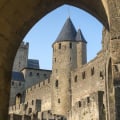LA CITÉ MÉDIÉVALE DE CARCASSONNE
Take a tour of one of Europe's largest fortified towns! On the programme: the Château Comtal, its towers, and ramparts.
Imposing and majestic, with its gigantic ramparts and 52 towers that look like they came straight out of a film, the medieval Cité de Carcassonne fascinates and leaves no one indifferent. Listed as a UNESCO World Heritage Site since 1997, the Cité attracts over 2 million visitors every year, making it one of the most visited sites in France. With its blend of history, architecture and culture, Carcassonne is a true jewel of heritage, a machine that takes you back in time.
More than 2,000 years ago, in the 6th century BC, a fortified village was built on a hill between the Massif Central and the Pyrenees. This strategic site was right at the crossroads of routes linking the Mediterranean to the Atlantic, and Spain to the rest of Europe. Carcassonne soon became an essential crossroads for merchants, travelers and armies.
In the 1st century BC, the Romans invaded Gaul, and Carcassonne became a prosperous Gallo-Roman city. For three centuries, Roman peace allowed the city to develop. But by the end of the 3rd century, barbarian invasions were on the increase, and Carcassonne had to strengthen its defenses. This is when the famous 9-meter-high, 4-meter-thick city walls appeared, supported by 38 towers that turned the town into a veritable fortress. However, these walls were not enough to stop the Visigoths, who took Carcassonne in 413. The town remained under their control for almost three centuries, before coming under the rule of the Moors, then the Franks in 759, under Pepin the Short.
In the 8th century, Carcassonne became an important part of Charlemagne's kingdom. After his death, the empire fragmented into counties and viscounties, and Carcassonne fell into the orbit of the powerful lords of Languedoc. In 1082, the Trencavel family took control of the town and launched a major building program. Among the most emblematic was the Basilica of Saint-Nazaire. At the same time, construction of the château comtal began, adding a new dimension to the medieval fortress.
In the 12th century, Carcassonne was a crossroads of wealth, but also of tension. The city found itself caught between the powerful counties of Toulouse and Barcelona. This is where Catharism comes in. This religious movement, made up of followers known as "perfects", contradicted the principles of Catholicism at the time. It developed strongly in Languedoc, and greatly worried Pope Innocent III. In 1208, he launched a crusade against the Cathars, and the crusaders landed at Carcassonne. After a two-week siege, the city fell, and Viscount Trencavel, accused of supporting the heretics, was imprisoned. The town was then offered to Simon de Montfort, leader of the crusaders.
In 1226, Carcassonne became part of the French crown, after Louis IX took the town. The threat of invasion, particularly from the King of Aragon, was ever present, and the king decided to extend the fortifications to make the town even more impregnable. He had a second wall built around the first, with new towers and a barbican to defend the entrance to the town. Carcassonne thus became a model medieval fortress, virtually invincible and capable of withstanding long sieges.
From the 15th century onwards, with the development of the lower town, the Cité gradually fell into disrepair. In the 18th century, it was even threatened with destruction. But, as if by a miracle, the Cité was saved thanks to the intervention of a visionary architect: Eugène Viollet-le-Duc. In the 19th century, he launched an ambitious restoration campaign that restored the Cité to its medieval appearance. Although controversial, the work preserved this unique heritage and helped the Cité rise from the ashes.
Today, the Cité de Carcassonne is a true place of life, culture and history. As you stroll along its cobbled streets, you'll be transported back to the Middle Ages, while discovering a modern, dynamic city full of entertainment and events. Classic guided tours, horse-drawn carriage rides and miniature train rides coexist with more innovative experiences such as treasure hunts and virtual reality tours. There's something for everyone!
Carcassonne is also a city that lives to the rhythm of its festivals. The Festival de la Cité, one of the region's biggest cultural events, attracts international artists every year. Concerts, plays, shows... the Cité becomes a huge open-air theater. But that's not all: events such as the Convenanza Festival (electro-rock), the Christmas illuminations and the Carcassonne Game Festival make every season an opportunity to celebrate the city's history and culture. Carcassonne isn't just a place to pass through, it's also a place to share and meet.
Since 2024, for the first time in centuries, it has been possible to take a complete tour of the ramparts. After major restoration work, the front of the walls is once again accessible, offering visitors a 1.3 km route. It's never been easier to discover the Cité from another angle, with breathtaking panoramic views of the Pyrenees, the Black Mountain and the lower town.
Did you know? This review was written by our professional authors.
The strengths of this establishment:
Members' reviews on LA CITÉ MÉDIÉVALE DE CARCASSONNE
The ratings and reviews below reflect the subjective opinions of members and not the opinion of The Little Witty.












We took the self guided tour with audio, which explained the different areas and time frames of construction.
How lucky that these structures still stand for all of us to see
We also sat at a cafe and absorbed the atmosphere around us.